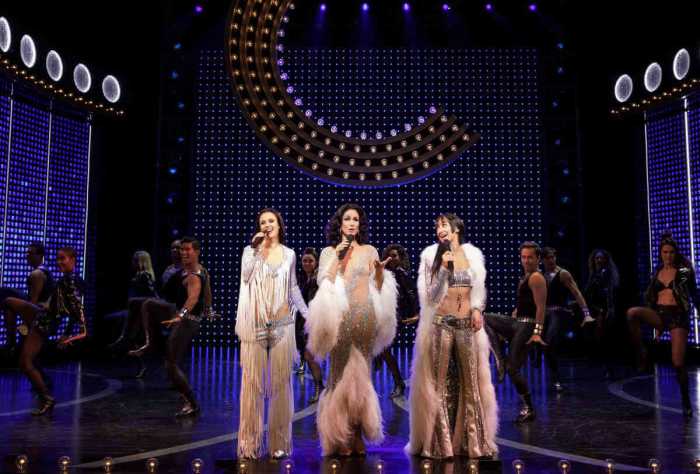Tina Benko and Arliss Howard in Ingmar Bergman’s “Scene from a Marriage,” directed by Ivo Van Hove. | JAN VERSWEYVELD
BY DAVID KENNERLEY | When “Scenes From a Marriage,” Ingmar Bergman’s lacerating TV miniseries about a marriage gone sour, premiered in Sweden 1973, that country’s divorce rate reportedly doubled. The filmmaker even had to get an unlisted phone number to avoid the flood of calls from strangers seeking conjugal advice. Later, the series was condensed into a feature film for US release.
Apparently, the Bergman classic was not searing enough for avant-garde director Ivo Van Hove. In adapting the work for the stage (based on Emily Mann’s English translation), he conceived an ingenious, brash framework designed not just for maximum emotional punch but also maximum discomfort. The result is at once fascinating and excruciating.
Be forewarned — the running time is three and one-half hours, which includes a half-hour intermission, during which you may wish to pound back a couple of glasses of Chardonnay or ditch the play altogether and rush home to watch something more cheery, like repeats of “Game of Thrones.”
Adulterous Bergman film even more intense when translated to the stage
For Act I, the New York Theatre Workshop space has been reconfigured into three distinct mini-theaters, where audiences watch one of three half-hour scenes being staged simultaneously. After watching a scene, each group shuffles over to the next theater. The chronology of scenes depends on which group you happen to be in.
This is the In-Your-Face School of Drama, where you may find yourself just inches away from the action. You’ll witness violent spats over whether to go to Marianne’s parents for regular Sunday dinner, whether to terminate a pregnancy, or whether the couple should split. Some poor theatergoers get sprayed when a glass of cognac is tossed in somebody’s face (don’t worry, it’s obviously just water).
This daring production takes voyeurism and brutalism to whole new levels.
Not only are we meant to hear the muffled shrieks and slammed doors seeping from the neighboring scenes, but each theater has windows into a common central chamber where the action from all the theaters spills over, so we can catch glimpses of the other scenes as well. It’s supremely creepy and harrowing, ratcheting up anxiety levels even further.
And unlike other fiendish familial plays that are laced with comic relief — Neil LaBute’s wickedly wonderful “The Money Shot” comes to mind — there are scant moments of intentional levity. Most laughter is of the nervous variety.
As you’ve probably figured out, three different pairs of actors play the beleaguered Johan and Marianne. That they look nothing like their counterparts and have wildly contrasting acting styles only adds to the intrigue (or bewilderment, depending on your taste).
The strongest duo is Arliss Howard and Tina Benko, who triumph in a tricky scene. Johan announces he is fleeing to Paris with another woman, and instead of kicking him out, a shattered but hopeful Marianne dutifully and lovingly packs her hubby’s suitcase as if he were going on a business trip. While Susannah Flood and the studly Alex Hurt are also compelling, Dallas Roberts and Roslyn Ruff have a tough time convincing us that Johan and Marianne ever had a connection.
Also flummoxing is the unclear time period — one scene features a rotary phone, an iPhone, and an e-cigarette. Each scene features precious music from the era of the Bergman film, like “Fifty Ways to Leave Your Lover,” “Bridge Over Troubled Water,” and “The Windmills of Your Mind.” The nondescript wardrobe, of a somber palette, could have been purchased off the rack at Club Monaco.
Those brave enough to return for Act II will find all walls removed to reveal a vast arena stage. Which is fitting because it features an extended sequence involving all three pairs simultaneously duking it out. The long-overdue fight is cathartic for the couple; for us, however, it’s harrowing.
Not that “Scenes From a Marriage” doesn’t have something useful to say. It asks whether it’s really possible, or desirable, to live with the same person for a lifetime. It stresses the importance of having the courage to voice grievances, speak your truth, and accept a love that’s imperfect.
The electrifying, high-concept drama sharply articulates the myriad pitfalls of a rotten marriage — malaise, bickering, stale sex, lies, cheating, and vindictiveness. Problem is, as we become numb to the bedlam and grow to despise these fickle, “emotional illiterates,” the ideas nearly get lost.
SCENES FROM A MARRIAGE | New York Theatre Workshop, 79 E. 4th St., btwn. Second & Third Aves. | Through Oct. 26: Tue.-Fri. at 7 p.m.; Sat. at 8 p.m.; Sun. at 2 & 7 p.m. | $75 at nytw.org or 212-279-4200 | Three and a half hrs., with intermission



































